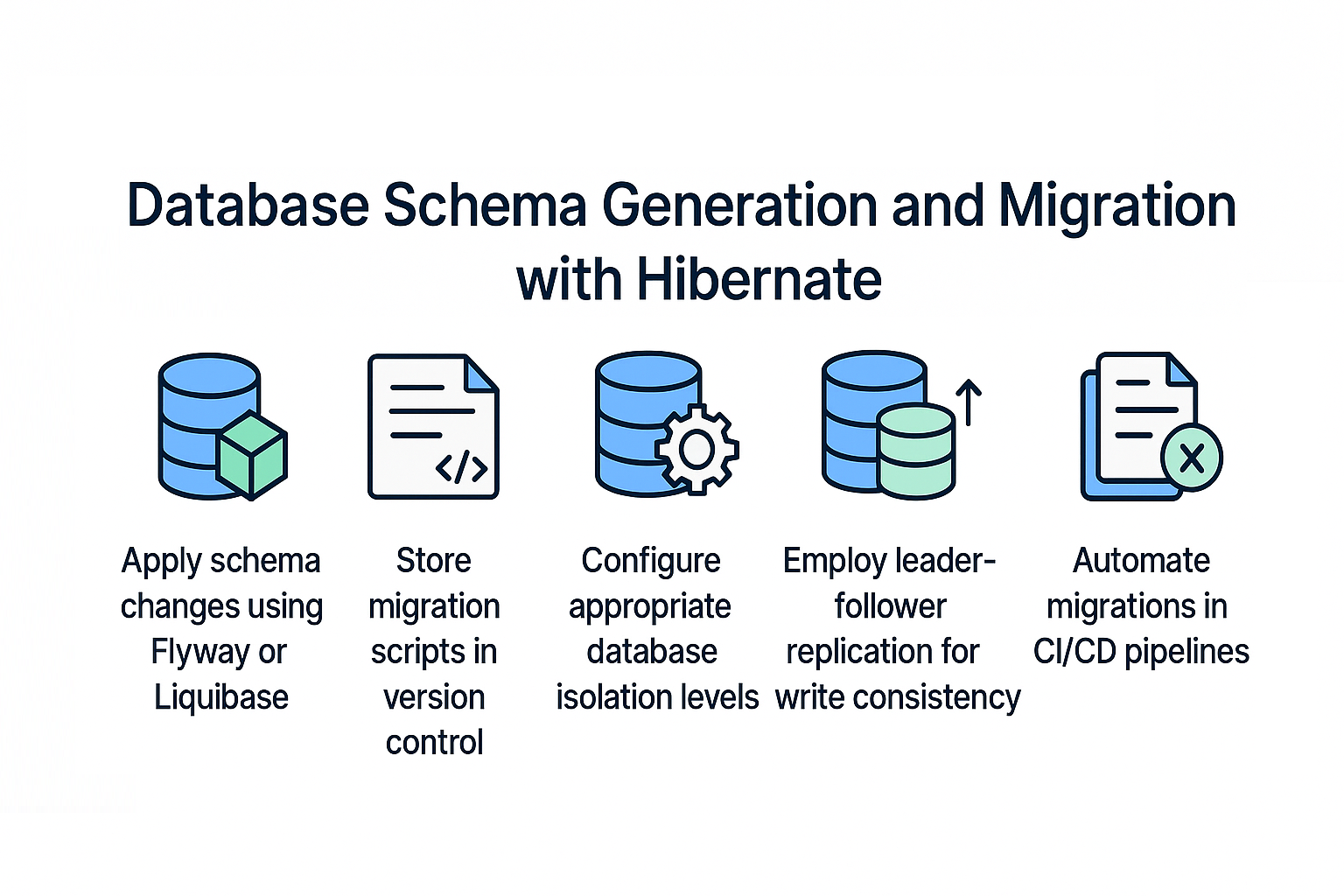Every real-world application evolves over time, and so does its database schema. Hibernate, as an ORM, provides automatic schema generation (hbm2ddl) for quick prototyping, but for production-ready systems, controlled migrations using Flyway or Liquibase are essential.
In this tutorial, we’ll cover:
- Hibernate’s schema generation with
hbm2ddl. - Migration strategies using Flyway and Liquibase.
- Integration with Spring Boot.
- Best practices for managing schema evolution in production environments.
Hibernate Schema Generation with hbm2ddl
Purpose
Hibernate can automatically generate, validate, or update database schemas based on entity mappings. This is controlled by the hibernate.hbm2ddl.auto property.
Configuration
spring.jpa.hibernate.ddl-auto=update
Options
- validate: Validate schema against entity mappings.
- update: Update schema to match entity mappings.
- create: Drop and recreate schema each time.
- create-drop: Drop schema when
SessionFactorycloses.
Example Entity
@Entity
@Table(name = "employees")
public class Employee {
@Id
@GeneratedValue(strategy = GenerationType.IDENTITY)
private Long id;
private String name;
private String department;
}
On startup, Hibernate will automatically create or validate the employees table based on the above entity.
✅ Best Practice: Use update or create only in development, never in production.
CRUD Operations with hbm2ddl
Create
Employee emp = new Employee();
emp.setName("Alice");
emp.setDepartment("Engineering");
session.save(emp);
Read
Employee emp = session.get(Employee.class, 1L);
Update
session.beginTransaction();
emp.setDepartment("Research");
session.update(emp);
session.getTransaction().commit();
Delete
session.beginTransaction();
session.delete(emp);
session.getTransaction().commit();
Limitations of hbm2ddl
- Risk of data loss when using
createorcreate-drop. - Not suitable for controlled production environments.
- Cannot handle complex migrations like renaming columns, splitting tables, or seeding data.
This is where Flyway and Liquibase come into play.
Database Migration with Flyway
Introduction
Flyway is a lightweight migration tool that manages schema evolution using versioned SQL scripts.
Setup
<dependency>
<groupId>org.flywaydb</groupId>
<artifactId>flyway-core</artifactId>
</dependency>
Configuration
spring.flyway.url=jdbc:postgresql://localhost:5432/demo
spring.flyway.user=demo_user
spring.flyway.password=secret
spring.flyway.locations=classpath:db/migration
Migration Script Example (V1__Create_Employee.sql)
CREATE TABLE employees (
id BIGSERIAL PRIMARY KEY,
name VARCHAR(255),
department VARCHAR(255)
);
Flyway automatically runs scripts in order (e.g., V1__, V2__), ensuring safe migrations.
✅ Best Practice: Store migration scripts in version control.
Database Migration with Liquibase
Introduction
Liquibase is another migration tool that uses XML, YAML, JSON, or SQL changelogs to define schema changes.
Setup
<dependency>
<groupId>org.liquibase</groupId>
<artifactId>liquibase-core</artifactId>
</dependency>
Configuration
spring.liquibase.change-log=classpath:db/changelog/db.changelog-master.yaml
Example Changelog (db.changelog-master.yaml)
databaseChangeLog:
- changeSet:
id: 1
author: dev
changes:
- createTable:
tableName: employees
columns:
- column:
name: id
type: BIGINT
autoIncrement: true
constraints:
primaryKey: true
- column:
name: name
type: VARCHAR(255)
- column:
name: department
type: VARCHAR(255)
Liquibase keeps track of applied changes in a dedicated DATABASECHANGELOG table.
Real-World Integration with Spring Boot
Both Flyway and Liquibase integrate seamlessly with Spring Boot. Simply include the dependency and place migration files in the configured directory.
Spring Boot executes migrations automatically during application startup.
Anti-Patterns and Pitfalls
- Using
hbm2ddl.autoin production → schema corruption. - Manually applying schema changes outside migration tools.
- Ignoring rollback scripts in production migrations.
- Mixing Flyway and Liquibase in the same project (choose one).
Best Practices
- Use
hbm2ddl.auto=validatein production to check schema correctness. - Apply schema changes using Flyway or Liquibase.
- Store migration scripts in version control.
- Automate migrations in CI/CD pipelines.
- Test migrations with production-like datasets.
📌 Hibernate Version Notes
Hibernate 5.x
- Uses
javax.persistence. hbm2ddl.autocommonly used for schema generation.- Works with both Flyway and Liquibase easily.
Hibernate 6.x
- Migrated to Jakarta Persistence (
jakarta.persistence). - Enhanced DDL generation and schema management APIs.
- Improved compatibility with migration tools.
Conclusion and Key Takeaways
- Use
hbm2ddl.autofor development speed, but not for production. - For production, prefer Flyway or Liquibase to manage migrations safely.
- Integrate schema migration into your CI/CD pipelines.
- Hibernate 6 improves DDL generation, but migrations remain critical for production systems.
Key Takeaway: Hibernate simplifies schema generation, but controlled tools like Flyway and Liquibase ensure safe and consistent schema evolution in enterprise environments.
FAQ: Expert-Level Questions
1. What’s the difference between Hibernate and JPA?
Hibernate is a framework that implements JPA with additional features.
2. How does Hibernate caching improve performance?
It reduces database calls by storing frequently accessed data in memory.
3. What are the drawbacks of eager fetching?
It loads unnecessary data upfront, slowing performance.
4. How do I solve the N+1 select problem in Hibernate?
Use JOIN FETCH, batch fetching, or entity graphs.
5. Can I use Hibernate without Spring?
Yes, but Spring Boot simplifies configuration and migration tool integration.
6. What’s the best strategy for inheritance mapping?SINGLE_TABLE for performance, JOINED for normalization, TABLE_PER_CLASS for flexibility.
7. How does Hibernate handle composite keys?
By using @EmbeddedId or @IdClass.
8. How is Hibernate 6 different from Hibernate 5?
Hibernate 6 uses Jakarta Persistence, has improved schema generation and query APIs.
9. Is Hibernate suitable for microservices?
Yes, but each microservice should own its database schema and migrations.
10. When should I not use Hibernate?
Avoid Hibernate when working with schema-less NoSQL databases or requiring extreme raw SQL performance.
